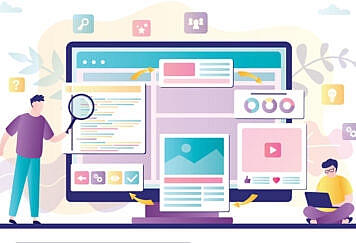IoT seems like a strange term to many people. Everyone with access to technology experiences IoT. The internet of things, also known as IoT, has disrupted numerous parts of our lives, including sectors like public transport and online shopping.
The IoT is a worldwide framework of interconnected devices with the capability to get and communicate data on a designated network. IoT is being heralded by many as one of the key features of the Fourth Industrial Revolution or Industry 4.0, as it is popularly known.
The total number of IoT devices is more than twice the number of humans alive. An estimated 14 billion devices form this tenet of technological disruption. One of the best parts of this new technology is that it imbibes a form of Artificial Intelligence. Connected IoT devices can communicate between themselves without explicitly needing human involvement.
Whether we realize that IoT is all around us, it still benefits humans in several ways.
In this article, you’ll learn some amazing facts about the Internet of Things.
10 interesting Facts about the Internet of Things (IoT)
Here are some interesting facts about IoT:
IoT is Part of Industry 4.0
Tech experts have referred to the industry shift towards new technologies as Industry 4.0 or the Fourth Industrial Revolution. Past industrial revolutions heralded the emergence of steam engines, electricity, assembly lines, and the adoption of the computer. The introduction of Industry 4.0 to the world will help limit the frequent occurrence of technological disruptions.
The IoT part of Industry 4.0 deals purely with automation. Smart sensors and machines perform actions without being programmed to do so. Suppose you’ve ever watched a science fiction movie. In that case, IoT’s automation is like how robots perform actions without all the exaggerated parts.
The First IoT Device was the ATM
The widespread emergence of ATMs began in the 1970s. The inventors interconnected ATM devices. Although Barclay’s Bank installed the first ATM in 1967, it started popping up everywhere sometime around the mid-1970s.
John Shepherd-Baron, who conceived the ATM idea, stated that he first thought of it after understanding how candy vending machines work. However, the first ATMs received checks and deposited 10-pound notes at the time.
The IoT concept began in the 1800s
The IoT concept formed in the early 1800s and interconnected devices were exclusively called IoT in 1999. Samuel Morse invented telegraph machines and Morse code transmitters in the late 1830s. Tech experts consider them as IoT devices because of their interconnected features.
Nikolai Tesla, the creator of the AC (Alternative Current) used in homes today, formed the virtual concept of IoT. In 1926, he envisioned a world where the globe would be networked like the human brain, with small devices that could be carried in pockets.
In 1964, Marshall McLuhan brought up the idea of smart cities. In 1966, Karl Steinbuch invented one of the earliest artificial neural networks.
IoT Significantly Boosts Productivity
The internet of things has led to key growth in work productivity in the manufacturing industry. Every sector of the economy that has incorporated IoT has recorded a productivity increase. Industry experts like Telenor are consistently working to boost the productivity of many firms in our society.
For instance, a study undertaken by the American Society for Quality has revealed that producers recorded over 80% increased productivity and a 49% decrease in product defects. IoT also allows firms to practice energy and resource efficiency, leading to optimal performance in the system.
IoT Produces Zettabytes of Data
A study has shown that IoT data has reached an estimated 20.6 zettabytes. To fully grasp this, a terabyte contains twelve zeros. A zettabyte in comparison contains 21 zeros. The number is exponentially greater than the 7.6 zettabytes reached by the end of 2016.
Nevertheless, the coronavirus pandemic has forced several companies to go digital, leading to heavier reliance on IoT data. Firms are already looking to solve this size issue with big data software that can crunch, analyze, and provide business intelligence from gargantuan-sized information.
IoT Devices Aren’t Always Small in Size
When several people think about IoT devices, they get the first ideas from movies where they seem minuscule in size. The fact is that while IoT devices can be really small, they could also be quite large. The size varies and depends on its applications.
IoT has some cybersecurity concerns
Where there are large amounts of data, you’re certain to find hackers lurking around to breach the system. In Las Vegas, an IoT sensor that collected information about the casino’s framework and employees was discovered.
There are several other ways security breaches can spring up in the IoT industry. Hence, cybersecurity firms are starting to build IoT security designs that specifically handle security concerns related to the Internet of Things.
IoT Technology is disrupting the Health Industry
One of the industries IoT highly impacts is the health sector. IoT devices help to monitor inventory and a patient’s vital organs. Patients don’t need to visit hospitals when their home medical devices are connected to the doctor’s. This helps to reduce hospital visits to emergencies.
IoT devices can also measure heart rates, blood glucose, pacemakers, etc. The Internet of Things remains at the forefront of the emerging telemedicine industry.
IoT Devices promotes the Creation of Smart Cities
Without IoT, the smart city concept would be a farce. However, with IoT, smart meters can help improve the efficient use of energy. Autonomous Interconnected vehicles can help manage traffic flow, and smart sensors can prevent waste and air pollution. Many more technologies and inventions are changing the world.
IoT Professional Jobs are Booming
IoT is a tech-related industry. The tech-related industry requires hardware developers, software developers, and systems engineers. However, with the vast amount of data collected daily, data scientists and data analysts are also needed.
Conclusion
IoT is a term that is steadily creeping into several industries. It allows devices to become connected so data can be shared to make these devices smarter. There are several interesting facts about IoT.
The first ATM was the first IoT machine. IoT has its beginnings from the early 1800s, zettabytes of data are created by IoT, and the demand for professional IoT jobs are on the rise. Nevertheless, IoT has its pros and cons in the world. IoT makes life easier and is also prone to cyberattacks. To get the best from IoT and stay safe, one must be extremely careful.
Follow Techstrange for more!





